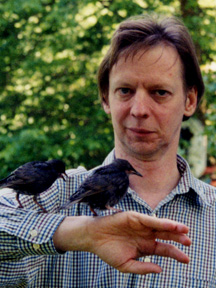
Welcome to the second installment of my periodic series on censorship issues large and small, concentrating especially on ways writers are discouraged from writing on or what they want. As you may recall from last week, I’ve asked a number of interesting authors to share their thoughts about subtle censorship — and I’ve been blown away by their enthusiastic and generous response.
I’m especially delighted to bring you today’s guest blogger, the inimitable and hilarious Bob Tarte, author of the brilliant pet memoirs ENSLAVED BY DUCKS and FOWL WEATHER. Bob’s got a great voice, highly personalized, an essential for effective memoir — anyone seriously interested in writing humorous memoir should take a gander (so to speak) at his seemingly effortless wit.
In case those of you who are not comedy writers are wondering why: there’s nothing more difficult than appearing to be spontaneously funny; it takes great art.
Those of you who have been hanging around Author! Author! for a while may recall Bob’s name: his is one of my standard examples of a fabulous author bio. If you haven’t yet written your bio (and you should be thinking about it, if you are querying or submitting; it’s not the kind of project that benefits from being tossed together at the last minute), you might want to check his out: in a scant few paragraphs, he manages not only to showcase his writing credentials beautifully, but also create an indelible impression of a fascinatingly quirky personality.
But let’s get to the question doubtless on everyone’s mind: what’s a pet memoir, you ask?
I’ll let Bob’s books speak for themselves — or at least the publisher’s blurbs do it for them. Let’s start with his first book, ENSLAVED BY DUCKS, to which I’m told Patricia Heaton from “Everybody Loves Raymond” has already bought the film rights:
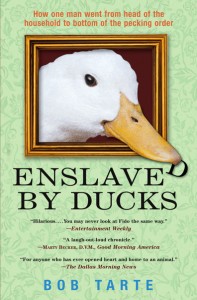 Enslaved By Ducks
Enslaved By Ducks
How One Man Went from Head of the Household to Bottom of the Pecking Order
When Bob Tarte left the city of Grand Rapids, Michigan for the country, he was thinking peace and quiet. He’d write his music reviews in the solitude of his rural home on the outskirts of everything.
Then he married Linda. She wanted a rabbit. How much trouble, he thought, could a bunny be?
Well, after the bunny chewed his way through the electrical wires and then hid inside the wall, Bob realized that he had been outwitted. But that was just the beginning. There were parrots, more rabbits, then ducks and African geese. The orphaned turkeys stranded on a nearby road. The abandoned starlings. The sad duck for sale for 25 cents.
Bob suddenly found himself constructing pens, cages, barriers, buying feed, clearing duck waste, spoonfeeding at mealtime. One day he realized that he no longer had a life of quiet serenity, but that he’d become a servant to a relentlessly demanding family: Stanley Sue, a gender-switching African grey parrot; Hector, a cantankerous shoulder-sitting Muscovy duck; Howard, an amorous ring-neck dove; and a motley crew of others. Somehow, against every instinct in him, Bob had unwittingly become their slave.
He read all the classic animal books — The Parrot Who Owns Me, The Dog who Rescues Cats, Arnie the Darling Starling, That Quail Robert, The Cat Who Came for Christmas — about the joys of animals, the touching moments. But none revealed what it was really like to live with an unruly menagerie.
Bob Tarte’s witty account reveals the truth of animal ownership: who really owns who, the complicated logistics of accommodating many species under one roof, the intricate routines that evolve, and ultimately, the distinct and insistent personalities of every animal in the house – and on its perimeter. Writing as someone who’s been ambushed by the way in which animals — even cranky ones — can wend their way into one’s heart, Bob Tarte is James Herriott by way of Bill Bryson.
Then there’s FOWL WEATHER, one of NPR’s Nancy Pearl’s Under-the-Radar Books for January 2008. Quoth Madame Nancy: “If you’re longing for a book that will make you laugh out loud, then run, don’t walk, to the nearest library or bookstore and pick up a copy of Bob Tarte’s Fowl Weather.”
Before you lose yourself in daydreaming about receiving a review like that, cast your eyes over the official blurb:
 Fowl Weather
Fowl Weather
How Thirty-Nine Animals and a Sock Monkey Took Over My Life
Bob Tarte’s second book, Fowl Weather, returns us to the Michigan house where pandemonium is the governing principle, and where 39 animals rule the roost. But as things seem to spiral out of control, as his parents age and his mother’s grasp on reality loosens as she battles Alzheimer’s disease, Bob unexpectedly finds support from the gaggle of animals around him. They provide, in their irrational fashion, models for how to live.
It is their alien presences, their sense of humor, and their unpredictable behaviors that both drive Bob crazy and paradoxically return him to sanity. Whether it’s the knot-tying African grey parrot, the overweight cat who’s trained Bob to hold her water bowl just above the floor, or the duck who bests Bob in a shoving match, this is the menagerie, along with his endlessly optimistic wife Linda, that teaches him about the chaos that’s a necessary part of life.
No less demanding than the animals are the people who torment Bob and Linda. There’s the master gardener who steps on plants, the pet sitter applicant who never met an animal he didn’t want to butcher, and a woman Bob hasn’t seen since elementary school who suddenly butts into his life.
With the same biting humor and ability to capture the soul of the animal world that made Enslaved by Ducks such a rousing success, Bob Tarte shows us that life with animals gives us a way out of our small human perspectives to glimpse something larger, more enduring, and more wholly grounded in the simplicities of love — even across species lines.
Speaking of radio, Bob also hosts a podcast for PetLifeRadio.com called What Were You Thinking? that is, he says, ostensibly about exotic pets, but as frequently lapses into “a chronicle of life with his own troublesome critters.” It’s well worth a listen, whether you own pets or not.
As clever souls among you may well have gathered by now, I’m a great admirer of Bob’s work — which is currently available both on Amazon US, with a different cover on Amazon Canada and Amazon UK, and, for the indie bookstore-minded, Powell’s, should you be interested. However, that’s not the only reason that I’m genuinely tickled to present his guest post today as a combination Orthodox Easter treat (it’s Sunday, in case you were wondering; like many another nice Greek-American girl, I’m cooking up a storm even as you read this) and reward to all of you for having made it successfully through my recent very dense HOW DO MANUSCRIPTS GET PUBLISHED, ANYWAY? series.
When Bob and I were discussing his guest post, I realized something startling: I have literally never run a post about how an author might handle readers’ responses to his work. How on earth had I missed the topic of the fan letter — and the anti-fan letter? Bob has been kind enough to remedy this oversight — and to give us his insight on how seemingly uncontroversial topics can abruptly bloom into a forest of unexpected feedback.
So join me, please, in a big round of applause for today’s guest blogger, Bob Tarte. Take it away, Bob!






I write humorous books about pet ducks and bunnies. And I get hate mail.
Most of the comments from readers of Enslaved By Ducks and Fowl Weather josh me about spoiling our animals, and deservedly so. My wife Linda used to sing a lullaby to our grumpy rabbit Binky. And we once kept a goose named Liza on our front porch for an entire summer while nursing her through a lung infection — plying her with bowls of duck pellets, dandelion greens, water, and gourmet-quality mud.
So I’m surprised when I’m occasionally scolded for not lavishing enough care upon our pampered critters. And a few times, I’ve been accused of outright animal abuse.
“You People Make Me Sick”
Binky died from an unknown malady after acting listless for a few days. Linda rushed him to the vet when he suddenly grew worse. After we had buried him, I was so distraught that I constructed a neurotic backyard monument to him complete with winding walking paths.
We hadn’t realized that once a bunny shows signs of illness, it is often too late to help. We had read books on keeping rabbits, phoned the breeder frequently for help, and did our best for him. But this was in the pre-Internet era when life’s mysteries were further than a Google search away. We know much more about our critters now, though this doesn’t make us feel any better about past mistakes.
Maybe I should have included a disclaimer to this effect. A reader responded to Binky’s story in Enslaved By Ducks by sending me a sheet on basic rabbit care adorned with a sticky-note that said, “You people make me sick.”
The same book contains the story of Weaver, a starling we rescued who was unable to fly. We had just started raising and releasing orphaned songbirds for Wildlife Rehab Center in Grand Rapids, and Linda successfully brought Weaver and his siblings to a state of ear-splitting good health.
She fed them the standard-recipe formula that rehabbers use with insectivorous birds: kitten kibbles, pureed chicken baby food, a squirt of liquid vitamins, and water, all slushed together in a blender. Weaver eventually took wing and left us. But a reader emailed me, outraged and frothing at the keyboard that we had fed him such a concoction. “I would bring charges against you if I could,” she wrote.
Because of comments like these — as well as an online review criticizing Enslaved By Ducks as a lousy ‘how-to’ book, though I had written it as a ‘how-not-to’ book — I find myself over-explaining things these days rather than assuming that readers will realize we’re not secretly running a taxidermy service here. But there’s a stronger reason for over-explaining than staving off criticism from the occasional malcontent. I want to decrease the odds of my contributing to anyone’s animal mishap.
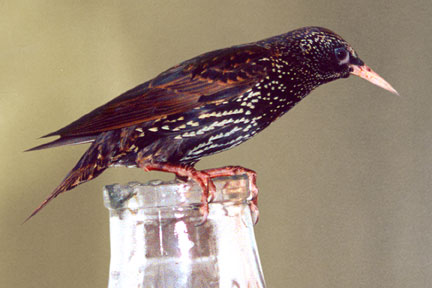
Weaver
Inoculate Yourself
Here’s an example of what I’m blathering on about. I’m writing a book about our six cats called The Funnel of Happiness. My sister Joan and her husband Jack with their 12 cats make several appearances, beginning with Jack live-trapping three feral cats with the help of a wireless video camera and the hindrance of many sleepless nights.
Once the cats are settled on the front porch, and after one of the females unexpectedly has kittens, Joan and Jack take them successively to the vet to get them spayed or neutered. Before releasing them into the house to mingle with Winston, Gizmo, Mimi, Linus, Libby Lou, and Max, they also have them tested for feline leukemia.
I mention this fact more than once in The Funnel of Happiness, but not because it contributes to my madcap narrative. I include it because I don’t want a single reader to introduce a feline leukemia-positive kitty into their home and endanger their other cats due to information that I failed to include.
Some details, however, are probably best excluded from a pet book.
In Fowl Weather I chronicled a horrendous July in which five of our animals died, including a Muscovy duck who managed to hang himself in the fencing while trying to get at a rival in an adjacent pen, and two khaki Campbell ducks that fell victim to a burrowing raccoon.
A reader chided me for being reckless about housing our animals, and he was right at least in the case of the industrious raccoon, but was fetching from afar when it came to the suicidal duck. We’ve taken steps to make the recurrence of these occurrences improbable, but it’s impossible to plan for everything.
This past March we lost more birds to a predator. I opened the barn one Saturday morning and was shocked to discover a dead and partially eaten hen on the floor. I didn’t see how any animal could have gotten inside, so I decided that the elderly chicken had succumbed to natural causes, and a rat, perhaps, had taken advantage of the situation. When closing the barn that evening, I checked the shadows for a lurking raccoon, then took care to batten down all hatches. The next morning two more hens had been killed.
Mink Attack
The banks of the Grand River are usually 500 feet from us. But they raised their skirts and scuttled to within 100 feet of our barn, thanks to an early March snowmelt and lots of rain. A mink apparently moved forward with the flowing water. We deduced this after our handyman Gary looked over the dead hens and concluded that an animal with a small mouth had killed them — and after a buddy of our neighbor’s reported seeing a mink cross his driveway after dark.
With Gary’s help, I fortified an old, unused chicken coop that occupies a corner inside the barn, covering the open side with chicken wire and plugging up any cracks and holes large enough to wiggle a couple of fingers through — because minks can weasel in almost anywhere. Linda examined the outside of the barn, identifying a slit in a window frame here, a knocked out knothole there, which I sealed as I best as I could.
Our rehabber friends weren’t encouraging, though. If a mink or weasel really wants to get inside, there’s little you can do to keep it out — especially if you house your ducks and chickens in a 100-year-old barn that’s not exactly airtight. Herding our birds into the coop, keeping the lights on, and playing a talk radio station for a few nights paid off, because we didn’t lose another bird.
In addition to shoring up structural security and setting live traps for the mink, we took a more direct and drastic step. We hired our friend Charlie to stand guard with his .22 rifle for a couple of hours after sunset the first two nights with our blessing to blast the mink into fur hat-dom if it reappeared.
I mention Charlie’s sentry duty in the “Mink Attack” episode of my podcast What Were You Thinking? for PetLifeRadio.com. And I’m planning on working the mink story into my cat book, which funnels in tales of our other animals. But I haven’t made up my mind whether or not to include Charlie’s contribution. It’s probably best to leave it out. Many people who read pet memoirs are opposed to killing animals under any circumstances.
I’m with these folks in spirit. But I loved the hens that died. They were delightful creatures who greeted me at the barn door for treats each evening, pressing so close that I had to carefully wade through the flock. So, in a choice between losing more chickens or forfeiting a mink, I picked the hens, or would have, had it come down to that choice. Charlie never caught a glimpse of the nocturnal marauder. The river receded, and our birds once again have the full run (and flight) of the barn each night.
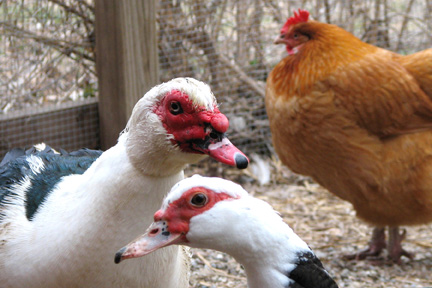
Victor, Juanita, and Two Tone
It’s Hopeless, So Just Give Up
In the end, you can write and write and write, but people will still read into your book whatever they want to.
At the beginning of Fowl Weather I include a cast of characters, because our many animals (36 at the time) are hard for readers to keep track of. I grouped the cast under three headings: ‘Nonhuman’ for animals, ‘Humans’ for us lesser beings, and ‘Inhumans’ for entities like the telephone that have power over our lives. Just for a gag, I put my friend Bill Holm in the ‘Nonhuman’ category to emphasize his standing as an annoyance.
A book reviewer for a North Carolina newspaper was generous in her positive comments about Fowl Weather. And she chuckled about the scenes that featured my “imaginary friend Bill Holm.”
Being imaginary came as quite a bombshell to the real-life Bill Holm, who insists that he exists, and if he doesn’t, people who have heard him speak when he accompanies me on book signings are due for intensive therapy. Apart from the joke in the cast of characters, nothing in the book suggests that Bill is merely a product of my imagination, even though from time to time I find myself wishing that he were.
That critic accurately recounted all other facts about Fowl Weather in her review, unlike another who groused that she found it impossible to finish the book because of its supposed prejudice against the elderly. Ignoring the fact that I’m hardly in the bloom of youth myself, the comment is breathtaking considering that a major thread of the memoir is my mom’s fight with Alzheimer’s disease and my family’s efforts to help her. I’ve received countless emails from readers who are going through a similar situation with a family member, and to a person they have appreciated how I treat the subject.
A few years ago, Linda ran an ad in our local paper seeking help with a strenuous landscaping job. One man who applied had an obvious physical impairment that made it difficult for us to imagine how he could perform the work. When I wrote about the incident in Fowl Weather, I didn’t want readers in our community to say, “Oh my, gosh, that’s so-and-so,” so I disguised the man by making him asthmatic.
I also often play fast and loose with the gender and location of our vets, since there are so few avian veterinarians in our county and they could be readily identified. Nevertheless, I get emails that say, “Hey, we go to the same guy.”
Anyway, that critic who accused me of age discrimination decided that my passage about the asthmatic was more evidence of my grudge against the elderly, even though the age of the fellow was never alluded to in any way.
I should have noted in Fowl Weather that he was in his forties, and I should have taken pains to emphasize Bill Holm’s corporeality, too.
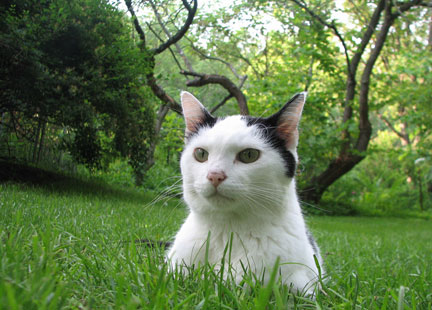
Frannie
Unbearable Recklessness
This brings me back to the reader who posted the online comment that we lost some of our animals due to substandard housing. The afternoon of the second mink attack, Linda took a walk through the woods behind our house by sticking to the high ground (which I need to learn to do in my books). Spotting what she thought was a crow’s nest in a tree, she focused her binoculars and backed slowly away after realizing that the big brown heap was, in fact, a bear.
I didn’t believe her at first. We’re way too far south in Michigan for bears, but I saw the sleeping animal myself and backed away at a speedier clip than she had.
In the fifteen years that we’ve been keeping ducks and hens in our barn, we’ve never had problems with a mink until this spring. I’ll explain this in The Funnel of Happiness, of course, partly to alert other poultry keepers of a potential problem if they live near a river, and also to ward off criticism that we were reckless enough not to have identified every possible element that might go wrong in our lives.
But what if the bear had come crashing through the woods to tear our backyard goose pen apart as if it had been made of matchsticks? What potential havoc might Michigan’s version of Bigfoot wreak on the outdoor pets? Shouldn’t we anticipate these potential threats and act accordingly?
I’m afraid I can’t answer these questions. I’m too busy at the moment. I’ve started work on a meteor deflection screen for the top floor of the house to protect our parrots on the first floor, and I’ll definitely include the plans in the appendix of my next book.
I just hope I’m not overdoing the over-explaining. It’s humorous pet book I’m writing, after all.
 Bob Tarte and his wife Linda live on the edge of a shoe-sucking swamp near the West Michigan village of Lowell. When not fending off mosquitoes during temperate months and chipping ice out of plastic wading pools in the depths of winter, Bob writes books about his pets, namely Enslaved by Ducks and Fowl Weather. He’s currently working on a book about his six cats called The Funnel of Happiness.
Bob Tarte and his wife Linda live on the edge of a shoe-sucking swamp near the West Michigan village of Lowell. When not fending off mosquitoes during temperate months and chipping ice out of plastic wading pools in the depths of winter, Bob writes books about his pets, namely Enslaved by Ducks and Fowl Weather. He’s currently working on a book about his six cats called The Funnel of Happiness.
Bob has written the Technobeat world music review column for The Beat magazine since 1989 and posts his columns at . He has also written for The New York Times, The Boston Globe, and The Miami New Times newspapers.
He hosts a podcast for PetLifeRadio.com called What Were You Thinking? that’s supposedly about ‘exotic pets’ as a general topic, but just as often turns into a chronicle of life with his own troublesome critters. For a direct link to Bob’s show, click here.)
Bob and Linda currently serve the whims of over 50 animals, including parrots, ducks, geese, parakeets, a rabbit, doves, cats, and hens. They also raise and release orphan songbirds (including woodpeckers) for the Wildlife Rehab Center, Ltd. in Grand Rapids and have the scars to prove it.
Visit Bob Tarte’s website for photos of Bob, Linda, and the animals, information about Bob’s books, links to Bob’s music review website and pet podcast, Bob’s email address, and several totally useless videos.






One of the things I like best about Bob is how generous he is with his time and his writing knowledge. He helped me craft a query letter that got the attention of several agents, and he’s always willing to answer questions and make suggestions. In addition, he comes up with genius ideas like the meteor deflection screen – hey, Bob, can I get a copy of that plan?!
This is Bill Holm speaking, and, contrary to Bob’s assertions, I most certainly do not exist. I’ve begged him to let me stay unalive in blissful oblivion, but he keeps conjuring me, and his portrayal of me is not exactly flattering. Were I to be an actual human being, I would sue. His continual assertions that I do exist worry his two or three friends–and I’d worry, too, if I were ever to exist. To be fair, Bob is honest about his insanity, not to mention his poor judgement, in his books, so maybe there’s hope. After all, one must be aware of one’s problems before the healing can begin. To paraphrase one of the perspicacious readers who excoriated Bob: “I would have Bob committed if I could.” For his own good, of course.
A lesser blog host might object to figments of anyone’s imagination posting their opinions, but I say the more input from the dark corners of the mind and parallel universes, the better!
Actually, it’s my readership that’s largely imaginary.
Must be the same as mine!
Dave
Nice hearing from you, Dave… if you actually exist.
This is Bill’s wife here to attest that while Bill may be imaginary to Bob, he’s a dream to me….a dream come true.
Very funny stuff. Thanks.
Writing is an Art, being humorous shows a level of intelligence beyond many others. Many artists have critics…some may not like one artifact by one artist but love another by someone else. The piece loved could be totally inappropriate, but nevertheless it is Art. An expression that is the artists that should not be altered by those that either don’t understand a piece, find some offensive, or simply don’t respect the expressiveness of art. I would not have told Picasso how to paint or why he should not have painted a piece. I would not tell an author what to write or not to write. Those that do will take the art from the artist and should be ashamed of themselves. Keep being funny, don’t worry about what others may or may not do….I would worry more about the fact that they do not respect the art of comedic writing and life lessons, those critics may need some help!